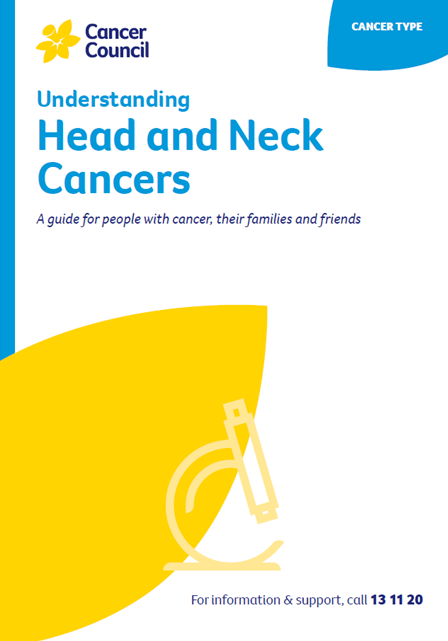Head and neck cancers
If you’re affected by head and neck cancer, you may have many questions about how it is diagnosed, treatment options, side effects and how to stay well. You can find trustworthy information about all aspects of your experience below.

Download PDF
For your community
Diagnosis
- What type of head and neck cancer do I have?
- Has the cancer spread? What do the staging numbers mean?
- Are the latest tests and treatments for this cancer available in this hospital?
- Will a multidisciplinary team be involved in my care?
- Are there clinical guidelines for this type of cancer?
- Who can I speak to for support?
Treatment
- What treatment do you recommend? What is the aim of the treatment?
- Are there other treatment choices for me? If not, why not?
- I’m thinking of getting a second opinion. Can you recommend anyone?
- How long will treatment take? Will I have to stay in hospital?
- Are there any out-of-pocket expenses not covered by Medicare or my private health cover? Can the cost be reduced if I can’t afford it?
- How will we know if the treatment is working?
- Are there any clinical trials or research studies I could join?
Side effects
- What are the possible side effects of the treatment? Will they be permanent?
- Will I have a lot of pain? What will be done about this?
- Can I work, drive and do my normal activities while having treatment?
- Will the treatment affect my sex life and fertility?
- Are there any complementary therapies that might help me?
- Will my face or neck have significant scarring or will I look different?
- Will I need to have a tracheostomy or stoma? Will my speech be affected?
- What kind of rehabilitation can I have?
After treatment
- How often will I need check-ups after treatment?
- If the cancer returns, how will I know? What treatments could I have?
Some cancers found in the head and neck area are not classified as head and neck cancers. We have separate information on brain cancer, cancer in the eye (ocular melanoma), cancer in the oesophagus, thyroid cancer and cancer of unknown primary.
Need to talk?
Call 13 11 20 to talk to a health professional Or email us your questions.